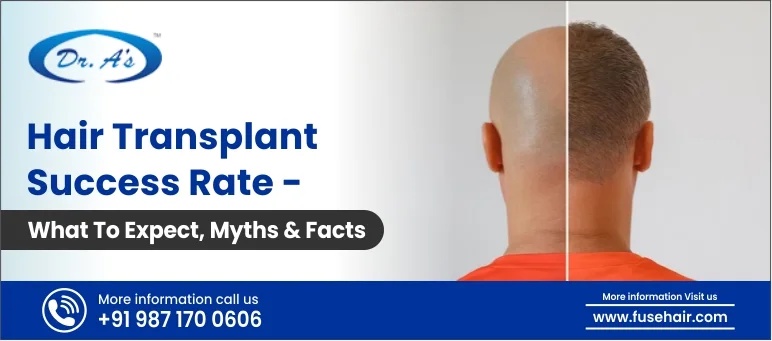Introduction
Hair loss is a common concern for many people, and hair transplant surgery has emerged as a popular solution to combat this problem. If you’re considering a hair transplant, one of the essential factors you’ll likely come across is the “hair transplant success rate.” Understanding what this term means, what you can expect, and dispelling some myths and facts surrounding it is crucial before making any decisions. In this blog, we’ll delve into the concept of hair transplant success rates, providing you with valuable insights to help you make an informed choice.
What Is Hair Transplant Success Rate?
The hair transplant success rate refers to the percentage of successfully transplanted hair follicles that grow and thrive after the surgery. It is a key metric used by hair transplant surgeons and clinics to assess the effectiveness of their procedures and to give potential patients an idea of the potential outcomes. The success rate can vary based on individual factors, such as the type of hair loss, the technique used, the surgeon’s expertise, and the patient’s overall health.
Factors Influencing Hair Transplant Success Rate
- Type of Hair Loss: Different types of hair loss, such as male pattern baldness, female pattern baldness, or alopecia areata, can influence the success rate. Patients with stable and non-progressive hair loss typically have better outcomes.
- Age and Health: Younger patients tend to have a higher success rate since their donor hair is usually more robust and long-lasting. Good overall health and lifestyle choices can also contribute to successful outcomes.
- Surgeon’s Experience: The skill and experience of the surgeon significantly impact the success rate. An experienced and qualified surgeon is more likely to achieve natural-looking and long-lasting results.
- Transplant Technique: There are various hair transplant techniques, such as FUT (Follicular Unit Transplantation) and FUE (Follicular Unit Extraction). Each method has its pros and cons, and the surgeon’s expertise in performing the chosen technique matters.
- Post-Operative Care: Proper post-operative care is essential for the transplanted hair follicles to thrive. Adhering to the surgeon’s instructions can significantly impact the overall success rate.
Myths and Facts about Hair Transplant Success Rate
Myth 1: 100% Success Guaranteed
Fact: While hair transplant procedures have come a long way and offer impressive results, it is essential to understand that no surgical procedure can guarantee a 100% success rate. The success ratHair Transplant Surgeriese can be high, but individual factors play a role in determining the final outcome.
Myth 2: Results are Immediate
Fact: Hair transplant results are not immediate. After the surgery, the transplanted hair will fall out, which is a normal part of the process. New hair growth usually begins within a few months, and it may take up to a year or more to see the full results.
Myth 3: Hair Transplants Look Unnatural
Fact: This myth is outdated. With advancements in technology and skilled surgeons, modern hair transplants can deliver incredibly natural-looking results. The transplanted hair blends seamlessly with the existing hair, making it difficult to distinguish.
Myth 4: Only One Procedure Needed
Fact: In some cases, a single hair transplant session may be enough to achieve satisfactory results. However, for more extensive hair loss or if a higher density is desired, multiple sessions may be necessary.
Conclusion
Understanding the hair transplant success rate is vital for anyone considering this procedure. While success rates are generally high, individual factors can influence the outcomes. Consulting with a qualified and experienced hair transplant surgeon is crucial to assess your suitability for the procedure and to set realistic expectations. Remember that patience is essential as results may take time to become apparent. By debunking myths and knowing the facts, you can make an informed decision and potentially regain a fuller head of hair with a successful hair transplant.


No comments yet